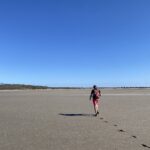A recent study by Curtin University lunar geologists probes the age and formation of one of the most prominent and visible features on the moon, the Imbrium crater.
For many years it had been suspected that the Imbrium crater was formed by a giant impact during the so-called Late Heavy Bombardment – an intense episode of giant impacts around 3,900 million years ago that marks the end of large lunar crater formation.
The Curtin study, led by geologists Dr Renaud Merle; Dr Marion Grange; Associate Professor Alex Nemchin and Professor Robert Pidgeon, and published in the journal Meteoritics & Planetary Sciences, reveals a more complex impact history.
The study shows that the Imbrium crater likely formed before the Late Heavy Bombardment, during a series of impacts that occurred over a period of 20 to 30 million years before the canonical age of 3,900 million years.
“The familiar face of the Moon, as we see it in the sky, is the most spectacular celestial object with bright rugged areas, and dark volcanic plains filling the craters. This striking aspect is due to an intense bombardment by objects of various sizes since the moon’s early formation,” Dr Merle said.
“For a long period of time it was accepted that the largest craters visible at the moon’s surface were the result of a few large impacts during the first 500 million years after the moon’s formation, among them the impact that created the Imbrium crater.”
The Imbrium crater is famous among geochronologists as it is supposed to be the landmark of the Late Heavy Bombardment.
“Despite more than forty years of geochronological work, the age of the Imbrium crater is still not well known, which is a subject of heated debate among the community of lunar geochronologists,” Dr Merle said.
Breccias are rocks formed in impact ejecta and often contain uranium-rich minerals like zircons and phosphates that can be used to date impact using the U-Pb radio-chronometer.
The Curtin Lunar Studies team analysed phosphates present in the breccias collected at the landing site of the Apollo 14 mission, which are interpreted to have formed during the impact that created the Imbrium crater.
The new age of 3,938 million years yielded by the phosphates is older by at least 20 million years than reported ages of the zircons from breccias formed during the Imbrium impact. This indicates that the breccias collected at the Apollo 14 landing site have recorded more than one impact and therefore are not all related to the Imbrium crater.
“The major outcome of this study is the challenging view of several impacts, large enough for the ejecta to cover wide areas of the moon’s surface, occurring during a relatively short period, 20 to 30 million years before the estimated Late Heavy Bombardment,” Dr Merle said.
The revised age of the formation of the Apollo 14 breccias was obtained using the Sensitive High-Resolution Ion Micro-Probe (SHRIMP) II device housed by the John de Laeter Centre at Curtin University.



